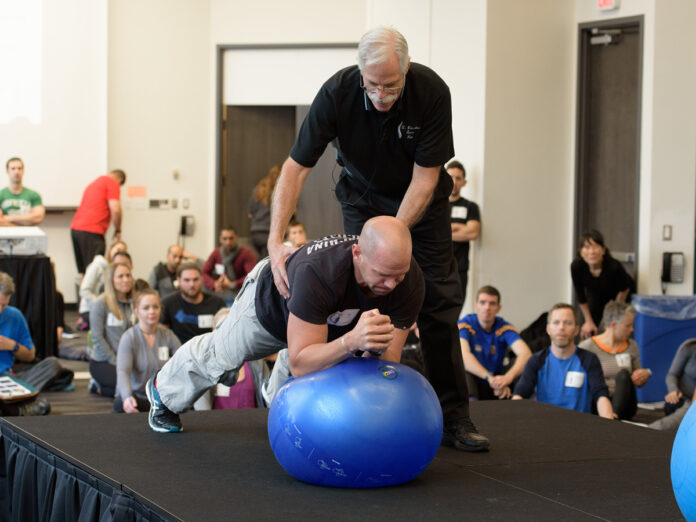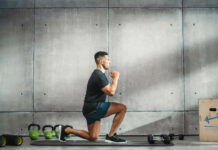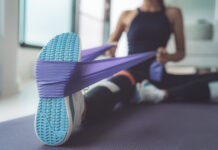
While some adhere to the mantra of no-pain, no-gain, Dr. Stuart McGill says the opposite is what a healthy back requires.
The world-renowned expert in back biomechanics has dedicated more than three decades studying spines on people, including hundreds of Olympians and elite athletes. To say McGill has the background and scientific evidence to support people in restoring pain-free function is an understatement. But the author of the wildly popular, Back Mechanic, says he cannot offer a five-easy-steps guide because, typically, there is no quick fix to back issues.
The McGill Method starts with determining the motions, postures and loads that cause pain together with ones that do not. The next step? Avoid exercises and activities that trigger pain and incorporate new ways to sit, tie your shoes, lift your children and even walk, coached by techniques in Back Mechanic. Allow the pain to cool down.
Essentially, recovery is about trading old habits for new ones.
“If you bite your lip every day for a week, your lip will be angry,” McGill says. “But doing lip exercises everyday will fail to get you out of pain. Instead, stop biting your lip.”
A comeback from a back injury starts with a proper assessment.
“Assessment is king but in the medical system, clinicians don’t get paid to listen to the patient’s story and perform a thorough assessment. But it’s the story that usually reveals why the person has failed to get better,” says the professor.
“There is no such thing as a “non-specific back pain” diagnosis – this just shows the person has not received a proper assessment . In fact, the pain pathway and mechanism is very specific.”
Designed to empower people with a step-by-step plan to rehab their backs, the McGill Method includes a guide coaching a self-assessment of pain triggers. Then specific movement hacks are coached around those. Tuning the body to move efficiently begins with the non-negotiable Big 3 exercises – the modified curl-up, the side bridge and the birddog/quadruped. And walking, which McGill refers to as nature’s balm, is incorporated into the program in doses designed to reduce pain rather than cause it.
Nearly all back pain can be controlled and altered but, McGill cautions, it will not be with a one-size-fits-all approach because people are not built the same.
“For example, some people have tall, slender spines. Some have large discs. Every single one of those (variances) gives a person a specific capacity,” he says.
“When you experience or create stress in your body there is a biological tipping point. Biology does not give you infinite capacity. And their pain-free capacity is further defined by their specific injury or pain trigger.”
With the proper matched approach, individuals can create beneficial stress that leads to adaptations which make them stronger and more resilient while those who push past their tipping point often see repercussions.
“People who fail to become pain-free often build stresses and cumulative damage faster than their body can respond and adapt,” McGill says.
There is also matching approaches with what works for your body.
“Take squats as an example. There is a back squat, a front squat, a safety bar squat, a hex bar squat. Each of these changes the stress locations in the body linkage. If a person has shorter legs and a longer body versus long legs and a short body, they squat very differently,” he says.
“Some people are wide squatters, some are naturally narrow due to variables such as the shape of their hip socket, and femur length. Choosing a mismatched squat will increase a stress concentration and decrease training capacity. Violating the tipping point increases the risk of injury and impedes athletic development. The answer and solution always comes back to the assessment.”
Working with top athletes such as powerlifters, a variety of Olympians, top fighters and golfers has shown McGill how they produce outstanding athleticism and resilience. He has distilled this knowledge for application to anyone. McGill says it’s not unlike auto manufacturing giant, Honda, who builds and tests a high-performance F1 race car and then transfers the technology into its Civic.
BACK TO BASICS
Six days on, one day off
McGill’s days of pushing his body past its tipping point, are gone. But he’s as committed as ever to backing up his body with what it needs to stay supple and strong.
“I am now 63 and I have zero pain. When I was a younger fellow, I had pains because I was building up cumulative stresses,” he says.
To keep his spine in line, McGill adheres to what he calls a “biblical work week,’ getting up at about 5 a.m. six days a week and doing his chores, typically physical labour around his home.
“Stay away from your computer in the morning. If you are a slave to your computer, you have made a deal with the devil to compromise your health,” he says. “My point is, get moving.”
Two days a week, he focuses on mobility, greasing up his neck, shoulders and hips so they can continue moving well and he does some thoracic work “because I don’t want to be a bent-over, old man.”
Two days a week are earmarked for strength training in movement patterns, which could be in Backfitpro HQ or it could be outside chopping firewood.
“Those days my focus is on strength and power, for example if I trip I can get my foot in front of me and arrest the fall. The goal is to be harder to kill,” he says.
“And two days a week, I get my ticker going a little bit with something else, a cross-country ski or a swim or a bike ride.”
“And, here’s the wisdom,” the distinguished professor adds.
“On the seventh day you don’t do anything. Let your body adapt.”
BRINGING SEXY BACK
Lovemaking that isn’t backbreaking
McGill’s real-people-real-problems approach took a quantum leap into unchartered territory as his laboratory launched an investigation into back pain from sex. Clinicians voiced that patients came to them with debilitating back pain causing them to be celibate, and no guidelines existed on the advice they should provide.
To tap into solutions, graduate student Natalie Sidorkewicz, measured muscle activation profiles, spine movements, and spine loads in couples (all in in long-term, committed relationships), while they were engaged in a variety of positions, literally, as to which postures and movements where most appropriate for people with specific pain triggers. The findings offered clinicians evidence-based guidance to talk about how to get back into sex with their patients.
“It’s actually back pain that sells, not sex,” says McGill with a smile. “
“At the end of the day, we do our work to help people. My objective is to change the lives of people who are suffering.”
He says solutions start with individuals knowing their pain triggers and focus on hip rather than spine motion.
“As a basic rule, if, during the act you are in the top position pain is less using the hips for movement rather than the spine. When in the bottom position, it is best to support the natural curves of the spine and avoid initiating movement. If your position of choice involves standing up in a canoe, you are my hero,” McGill says.
You may also like : Posture for Performance
IMPACT Magazine’s December 2020 Edition
Read about our top Canadian Olympic snowboarder who returned from injury and is chasing that elusive Olympic Gold! Learn how not to lose your momentum running through the cold and snow, work out with Canada’s Top Fitness Trainers, avoid back pain with one of the world’s most renowned experts and try out our delicious Holiday-themed recipes.
















